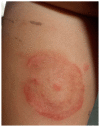Infection by Microsporum canis in Paediatric Patients: A Veterinary Perspective
- PMID: 29056704
- PMCID: PMC5644651
- DOI: 10.3390/vetsci4030046
Infection by Microsporum canis in Paediatric Patients: A Veterinary Perspective
Abstract
Microsporum canis is a dermatophyte fungus of which cats and dogs are recognized as the natural hosts. M. canis is also easily transmitted to humans, causing lesions to the glabrous skin (tinea corporis) and to the head (tinea capitis). The present study describes some cases of infection with M. canis in children from a veterinary perspective, highlighting some important features of this clinical entity (e.g., the necessity to identify the animal source of infection with appropriate diagnostic tests; the fact that infected cats may present with no or atypical dermatological signs; and the importance of the environment as a fungal reserve).
Keywords: Microsporum canis; cat; dermatophytes; paediatric; ringworm.
Conflict of interest statement
The authors declare that there are no conflicts of interest.
Figures





References
Publication types
LinkOut - more resources
Full Text Sources
Other Literature Sources
Miscellaneous

